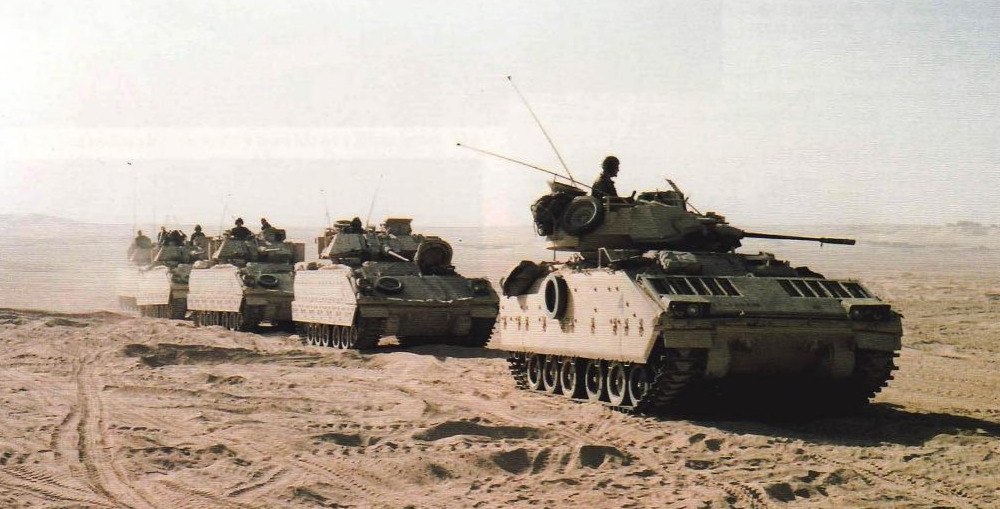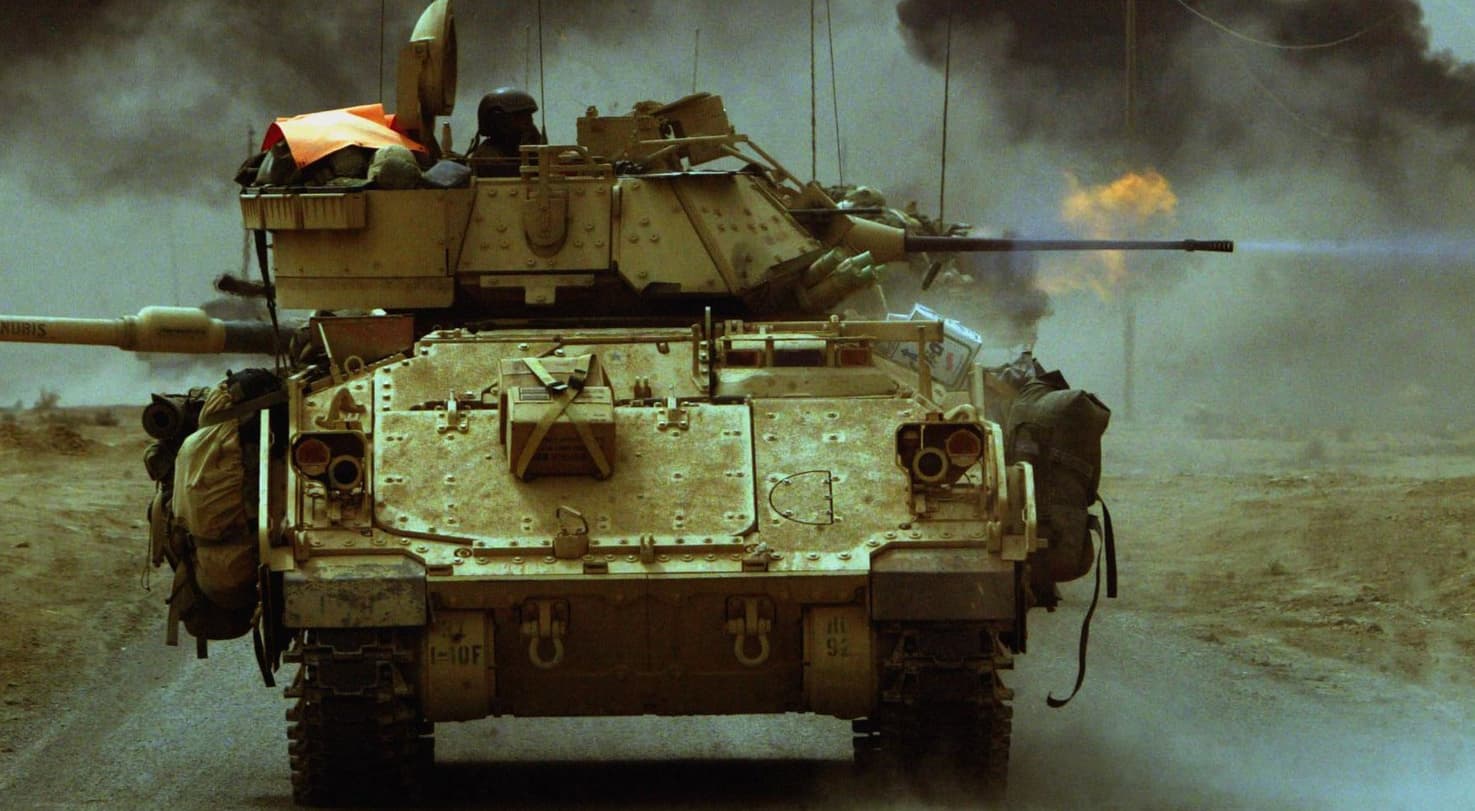Expand
M3 Origins
Development of the M2/M3 Bradley dates back to 1963 with the MICV-70 programme intended to create a lightweight, highly-mobile, well-armed APC to complement the MBT/KPZ-70, replacing the American M113 and M114 families as well as the German HS.30 family. Two vehicles were produced for this programme- the XM734 and XM701. Both were lightly armoured with a capacity of 9 dismounts and armed with the 20mm M139. The XM701 was selected for further development, but was found to be too heavy for air transport and the programme was put on hold in October 1965.
The introduction of the BMP-1 in 1967 restarted the development of the MICV-70 programme, this time with increased requirements for mobility, firepower, and protection. FMC had continued work on the XM734 as a private venture, developing the XM765 with increased armour and a new 25mm cannon. This vehicle would not be selected for the MICV-70 programme but did later see export as the AIFV. Also considered was the Marder, the German response to the initial collapse of the MICV-70 programme. However, the vehicle’s high cost and lack of amphibious capability ruled it out. Conflicting requirements resulted in significant delays in the progression of the programme. It wouldn’t be until 1972 that the Army submitted a final Request for Proposals for a pair of vehicles, one to replace the M113 and another to replace the M114. These programmes would result in the XM723 armed with a 25mm cannon and the XM800T/W, both armed with 20mm cannons. However, budget cuts and a desire for common components resulted in the cancellation of the XM800 programme with the XM273 expected to provide both troop transport and reconnaissance. To allow for the reconnasaince role, the commmaneder needed to be moved from the hull to a new two-man turret, replacing the original one-man one. To make maximum use of this new, larger, heavier, more epxensive turret, the new XM723 TBAT-II (TOW-Bushmaster Armoured Turret, 2-man) would be fitted with a twin launcher for the new TOW ATGM. The MICV programme had already far overran its budget and timeframe, so the resulting vehicle might as well be a dramatic upgrade over the M113.
In 1977 the MICV TBAT-II was selected for production in two versions. One, the XM2 Infantry Fighting Vehicle as-designed, for troop transport to replace the M113. The other, the XM3 Cavalry Fighting Vehicle, without gun ports and with more ammunition for both the Bushmaster and TOW and carrying only two scouts as dismounts.
These two vehicle would be type-classified as the M2 “Bradley” IFV (after General Omar Bradley) and M3 “Devers” CFV (after General Jacob Devers) in December 1979, with production starting in early 1981. In October 1981, the “Devers” name for the M3 would be dropped in favour of “Bradley” because of the similarity of the two vehicles.
The XM701 prototype, winner of the initial MICV-70 competition but otherwise unrelated to the M3
The XM723 has clear visual similarity to the later M2/M3, though it has a much smaller one-man turret
The M3 and M3A1
The M3 CFV proved immediately unpopular. Large, slow, and loud, it performed poorly as an independent scout vehicle. Doctrine at the time called for reconnaissance vehicles to move quickly and quietly, operating undetected and engaging forces only as a last resort in self defense. For this role, the M3 was ill-suited. On top of being too large, loud, and slow to operate undetected, its TOW launcher was deemed unnecessary. Additionally, the initial M3A0 model lacked NBC protection- the vehicle was a rush job in response to the Soviet BMP as well as the IFVs of other nations. The M3A1 of 1987 would introduce an NBC system for the three crew. The two dismounts would also benefit from this NBC system, unlike the dismounts of the similar M2A1 upgrade. The M3A1 additionally received for the first time the BGM-71D TOW-2. However, the M3A1 was only an interim solution while the more major M3A2 upgrade was under development. In the independent reconnaissance role, the M3 would be replaced by the smaller, faster, and quieter HMMWV. Instead, the M3 and M3A1 would begin to serve in a new role as an impromptu light tank supporting the M1 Abrams, with great success.
The M3A1 was a relatively minor upgrade over the M3
The M3A2
In 1986 it was determined the Bradley was underpowered and insufficient for countering more modern Soviet weaponry. An upgraded model was to be developed. This A2 model would have a more powerful engine to allow the Bradley to finally keep up with the Abrams like it was supposed to, as well as improved armour including provisions for ERA for protection against 30mm autocannon fire and infantry shaped-charge weapons such as the ubiquitous RPG series. Internal survivability changes included relocation of ammunition and fitting of spall liners.
Production of the M2A2 and M3A2 started in April 1988. The first 662 vehicles produced between April 1988 and May 1989 lacked the new 600hp Cummins engine as it was not yet ready.
Come February 1991 roughly half of Bradleys involved in Operation Desert Storm were A2 models.
The M3A2 introduced new steel applique, replacing the original aluminum skirts
size=4]In the Desert Storm[/size]
While the M3’s role in the First Gulf War wasn’t as significant as the M2’s, both served with distinction with the A2 Bradley being arguably the best armoured vehicle of the conflict.
First, the A2 Bradleys were highly reliable and available. Availability rates remained over 92% throughout the conflict, the highest of any Coalition armoured vehicle.
Mobility was also regarded as excellent, with Bradleys having good top speed, all-terrain capability, and excellent range. The main complaint was the reverse rate which was considerably lower than that of the Abrams.
17 out of the 20 Bradleys lost in the conflict were due to friendly fire, primarily from Abrams, meaning that there wasn’t much data on the effectiveness on the A2’s added armour. However, the increased armour greatly improved crew confidence which may have increased efficacy.
Where the Bradley was found most lacking was in firepower. The Bushmaster was effective against infantry, emplacements, and light targets, and could even destroy tanks at close range. The TOW could easily destroy an Iraqi tank from long range and was reliable, when it wasn’t loaded incorrectly or with damaged rounds. However, there were a number of issues with the firepower. First, the Bradley was designed for combat in the hilly, forested terrain of Europe where lines of sight were relatively short. In the wide-open desert crews found that the Bradley’s weaponry had a longer maximum range than targets could be accurately identified. This issue was shared with the Abrams and resulted in the high rates of friendly fire in the conflict. To fire the TOW, the vehicle needed to stop and remain stationary until impact. This left the vehicle exposed and crews requested a fire-and-forget replacement for future Bradley models. Finally, the lack of a laser rangefinder resulted in many targets being targeted outside of effective range.
Crews also expressed the need for navigation equipment in all Bradleys.
Finally, the optics for all crew members were found to be inadequate and in need of upgrades.

Desert Storm saw a variety of M3 models in use, but the M3A2 was the most numerous
Further Development
Shortly after Operation Desert Storm, an improved version the M2/M3 Bradley was developed, addressing some of the issues found during the conflict. These were aptly named the A2 ODS (Operation Desert Storm) model. Additions included a LRF, GPS and inertial navigation equipment, and improved thermal sights for all crew members. Later additions included the AN/VLQ-8 soft-kill APS and the BCIS IFF system. All ODS Bradleys were rebuilt from existing A2s.
Additional post-war upgrades to the Bradley not unique to any model included the TOW-2B, BRAT (Bradley Reactive Armour Tiles) ERA, and M919 APFSDS (which was available in small numbers during the conflict but was quite uncommon).
The improved M3A2ODS
